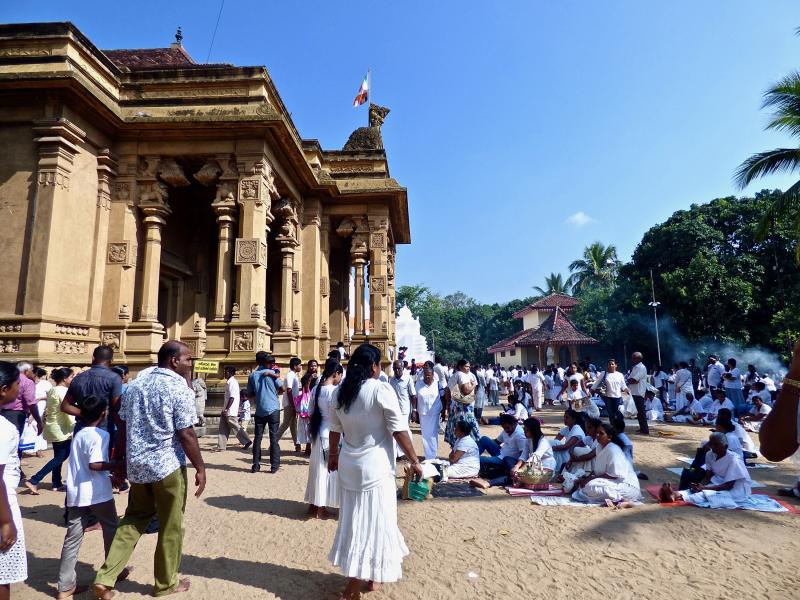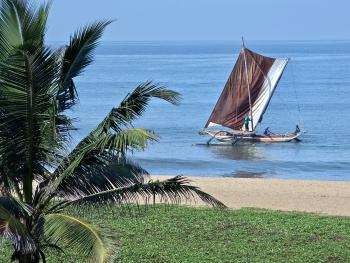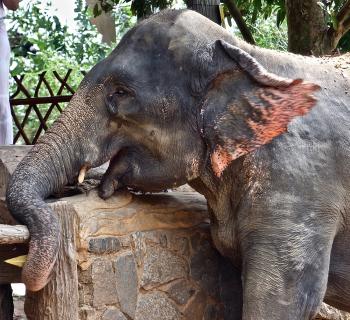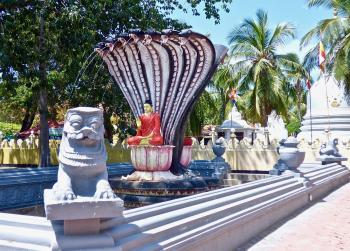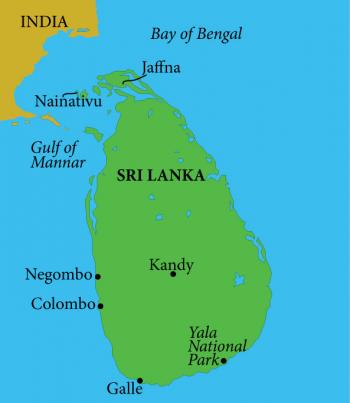A treasure trove of wonders in Sri Lanka
This article appears on page 6 of the September 2020 issue.
Interested in history, religion, art, animals, birding, swimming, hiking, scenery, ceremonies and UNESCO Sites? Then Sri Lanka’s the place for you! And it’s all packed into one easy-to-navigate island.
Poring over ITN magazines, I happened upon a write-up of a tour of Sri Lanka in which the author highly recommended Varini de Silva of Ceylon Express International (Huntington Beach, CA; 800/423-9566, ceylonexpress.com). What a find she was!
Varini, born and raised in Sri Lanka, immediately hooked me up with three ladies who she was sending off on an extensive tour of this island country, departing Feb. 15, 2019. I was particularly attracted to the tour because it would include a rare visit to Jaffna, in the Northern Province. What luck!
My cost for 16 days was $5,477, including a single supplement. We traveled in an air-conditioned van that would easily seat six and accommodated our luggage. All hotels on the tour were quite nice, well located and air-conditioned.
Pre-tour explorations
I began my tour in Negombo, staying on my own at the Heritance Negombo hotel, located right on the Indian Ocean. The picturesque catamarans floating by, unique birds fluttering around and the sand all were highly appealing.
My driver/guide while I was there, Naveen, was absolutely wonderful, arriving right on time and doing everything possible to give me an extraordinary experience.
We started with a boat trip on the waterways of the Muthurajawela Wetlands, home to many vibrant birds, mesmerizing monkeys and all sizes of monitor lizards. I particularly liked the yellow-and-blue-bodied kingfisher with its stunning bright-red beak.
My personal favorite highlight, however, was our visit to the Angurukaramulla Buddhist temple, which was absolutely alive with fiery, brilliantly colored sculptures, including a very large, reclining Buddha adorned in a bright-red robe.
A brilliant start
The next day, it was time to meet my fellow travelers in Colombo. And what did I see during the drive there? Elephants! They were traveling by foot and in trucks — I couldn’t believe my eyes!
It seems I was just in time for the festival known as the Nawam Maha Perahera. The timing was all part of Varini’s plan.
The festival parade was quite a spectacular event, even though there was a huge downpour of rain just as it started. Luckily, our group had reserved seats with a protective plastic overhang that covered our heads and cameras, so all was well. (And, yes, toilets were available.)
I attempted to photograph some of the more than 5,000 performers, including dancers, stilt walkers, drummers, fire dancers and other folks of many talents, along with the countless fancily draped elephants as they paraded before me. One very elegant, illuminated tusked elephant carried a replica casket of sacred relics to officially inaugurate the parade. It was a photographer’s dream.
The next day, our small group eagerly took off for Jaffna, where few travelers have been. This area, once the scene of great violence between the Tamil Tigers and the Sinhalese people of Sri Lanka, was open and ready for visitors.
We were excited to be able to visit the amazing sites there, and we immediately discovered that the people were delightful, warm and friendly.
We stayed at the very comfortable Jetwing Jaffna hotel, situated between the centrally located Clock Tower and a statue of Mahatma Gandhi, for three nights.
Jaffna, on a peninsula in Palk Bay, was a perfect gateway to the various sites that we were about to visit.
To the north
As we continued on our journey, the road transformed into a highway of temples, temples and more colorful temples — Hindu and Buddhist plus an occasional Christian church. The Hindu temples lit up the sky with large, towering entrance gates, each more ornately covered with painted sculptures of deities than the previous.
My favorite visit, though, was to the tiny island of Nainativu. As our ferry docked at Nainativu near the Nagadeepa Purana Vihara temple, I was immediately struck by a picturesque statue of Buddha seated in a fountain and protected by a 7-headed naga (snake deity).
A nearby fresco depicted the Buddha’s visit to the temple to mediate a dispute between two kings. I was soon to find out that Buddhism and Hinduism had influenced each other throughout Sri Lanka’s history.
Whisked away by tuk-tuk, we continued to the large Hindu temple of Nagapooshani Amman Kovil, dedicated to Parvati and her consort, Shiva.
As I neared the temple, live cows began to accompany me. Priests were giving a special blessing to babies, and we, too, were blessed.
A sculpture of Nandi, the bull, with fire pits for offerings, faced the entrance of the kovil. After feeling the energy there and viewing the many sculptures around the complex, it was, sadly, time to leave.
Ancient sites
As our group bade farewell to the Jaffna region, we drove off into the center of Sri Lanka to an area known as the Cultural Triangle, the cradle of incredible antiquities and historical events.
Its oldest city, Anuradhapura, was established in the 3rd century BC, at about the same time that Buddhism was rising. Anuradhapura is a very large area dotted by immense stupas and ancient palace ruins.
Polonnaruwa, another ancient city nearby, dating back to about AD 1070, has a great many temples, statues of Buddha, palaces, pools and even 7-storied structures in wonderful condition. The many Buddhas, each with a different facial expression, are absolutely amazing.
Not only do all the Buddhas have different facial expressions, but so do the other animals carved into the stone walls that surround all these wondrous structures.
In the same cultural district, we visited the ancient rock fortress of Sigiriya. It’s about 660 feet high, with about 1,200 steps leading up to it — yikes! About midway, there is a sheltered western wall with frescoes of absolutely gorgeous bejeweled ladies, dating from about the 5th century.
Farther up the road a bit, the Golden Temple of Dambulla is home to temple caves filled with stunning statues of Buddha. Once again there were stairs, and no shoes were allowed, but it is absolutely wonderful to see, if your feet are willing. (Sand, concrete and rocks can become extremely hot, so it is better to visit temples early in the day. Wearing socks is OK.)
Kandy
Kandy was our last stop in the Cultural Triangle, and what a stop that was! We arrived just in time for a wonderful, colorful performance of Sri Lankan dancing and music. The costumes were terrific and included fantastic masks. It all ended outside with the fire dancer, who actually put a fiery-tipped wand into his mouth.
Up early the next morning, we were off to the sacred city of Kandy, home of the Temple of the Sacred Tooth Relic. It was there that I truly learned of the compassion, warmth and respect that Sri Lankans had for others.
I found myself in a rather long line in the room housing the tooth. This sacred tooth of the Buddha is stored in a gold casket within six other gold caskets in a special chamber. The people in line honored me by continuously making room for me to progress quickly to the front of the line, where I could observe devotees and their offerings being blessed.
The devotees who were near the front suddenly realized that I didn’t have any offerings to present, so they shared lotus flowers with me from their own offerings. It was absolutely heartwarming.
The door to the chamber was then opened, and I gazed at the golden casket through the longish hallway leading to the chamber. I felt truly blessed.
It should be noted that I had just clicked off five UNESCO World Heritage Sites, for those of you who are counting.
Into the mountains
Our tour proceeded farther south through Nuwara Eliya, featuring mountains, waterfalls and tea plantations. It was time to relax, take in the scenery and sip some of the famous Ceylon teas.
We arrived in an area that is home to three nature parks. Elephants freely walked from park to park seeking water or whatever succulent tree branches or grasses they could find. Many Sri Lankan elephants have depigmented areas of skin that appear to be pink on their ears, trunks and backs, framing their faces and giving them a charming appearance.
Now, on to those parks! Sri Lanka is the leopard paradise of the world, at least according to the Yala National Park sign displayed there. Indeed, I did see one leopard.
I knew something was happening, as, suddenly, it seemed every vehicle in Yala Park was spinning around to rush somewhere. Sure enough, a leopard was peacefully laying in the distant grass. The gang-up of vehicles jockeyed to get the best vantage point.
Yala Park also graced our visit with wild boars, spotted deer, crocodiles, elephants, majestic peacocks, lizards, water buffalo and, of course, monkeys — an excellent array of wildlife for one island.
Coming to a close
As we made our way to our final destination, Galle, we visited an extremely interesting temple complex at Kataragama. At first it looked like a Hindu temple, then I saw a fenced-in bo (sacred fig) tree and a white stupa, both signs of a Buddhist temple. There was also a mosque, Ul-Khizr, in the complex.
My tour ended in Galle, a city with restored historical buildings, churches, hotels and a huge Dutch fort dating back to 1588. Galle is a shopper’s paradise, a perfect place to purchase remembrances of all the wonderful sites seen throughout Sri Lanka.
Seeing the sun set from the walls of the fort afforded a beautiful memory of a wonderful tour.

